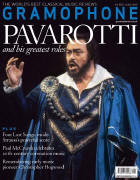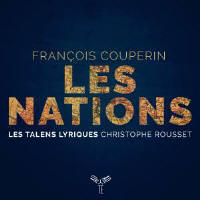Texte paru dans: / Appeared in: |
|
|
Outil de traduction (Très approximatif) |
|
|
Reviewer:
David Vickers Christophe Rousset and Les Talens Lyriques celebrate the 350th anniversary of the birth of François Couperin ‘le Grand’ (1668-1733) with two of the composer’s collections of chamber pieces. The Concerts royaux were published as a supplement to his third book of harpsichord pieces (1722); Couperin explained that they had been composed in 1714-15 and played at the royal court during Sunday concerts for Louis XIV. Violinist Stéphanie-Marie Degand, flautist Georges Barthel and oboist Patrick Beaugiraud occasionally play together in unison (the gorgeous Échos that concludes the Second Concert) and from time to time they mix colours when Couperin calls for a trio sonata texture, but for the most part the three treble instruments take solo turns. Beaugiraud’s entrancing soulfulness, Barthel’s sweet intimacy and Degand’s sophisticated phrasing all cultivate the emotionally touching qualities of Couperin’s artistry (the violin and flute whisper seductively to each other in the Sarabande from the Quatrième Concert). Continuo support from Rousset and gambist Atsushi Sakaï mines a rich seam of sonorities, from delicate pastoral charm (the Musette of the Troisième Concert) to the convivial finesse of lively dances (the Rigaudon and Forlane that conclude the set). Les nations (1726) consists of four ‘ordres’ written over a period of about 30 years. Although their titles claim to represent ‘La Française’, ‘La Piémontaise’, ‘L’Espagnole’ and ‘L’Impériale’ (the Holy Roman Empire), each commences with an Italianate trio sonata followed by an assortment of dances oscillating between Italian and French styles. The original part-books do not stipulate the instrumentation of the first and second ‘dessus’ (treble) lines. It is possible for Les nations to be performed simply as Corellian trio sonatas by two violins and continuo, as proved by the Purcell Quartet, but most interpreters mix and match a bigger range of instruments to their heart’s content – such as Jordi Savall’s all-star ensemble (freshly reissued and well worth revisiting) and this eloquent account by Les Talens Lyriques. There is effortlessly flowing momentum throughout these performances – such as the irresistibly lovely chaconne in ‘L’Impériale’ and the closing gigue of ‘La Piémontaise’, each played with gently lilting inégales and gracefulness. A pair of flutes (Jocelyn Daubigney and Stefanie Troffaes) murmur soft incantations over tenderly shaped continuo accompaniments in the sarabande of ‘La Française’. A quartet of two violins (Gilone GaubertJacques and Gabriel Grosbard), bass viol (Sakaï) and theorbo (Laura Mónica Pustilnik) create unfolding cascades of sensuousness in the sarabande in ‘L’Espagnole’. The woodwind trio of oboes (Josep Domenech and Thomas Meraner) and bassoon (Eyal Streett) play with jocular spontaneity in the buoyant second courante in ‘La Piémontaise’. Rousset’s spot-on harpsichord realisations, pacing and shaping of small details are never at the expense of the broader picture. A captivating breadth of characters, moods and sonorities are captured in the ideal acoustic of the Galerie Dorée, a ceremonial hall in the headquarters of the Banque de France, formerly the residence of the Comte de Toulouse (an illegitimate son of Louis XIV), for whom Couperin is known to have played. |
|




